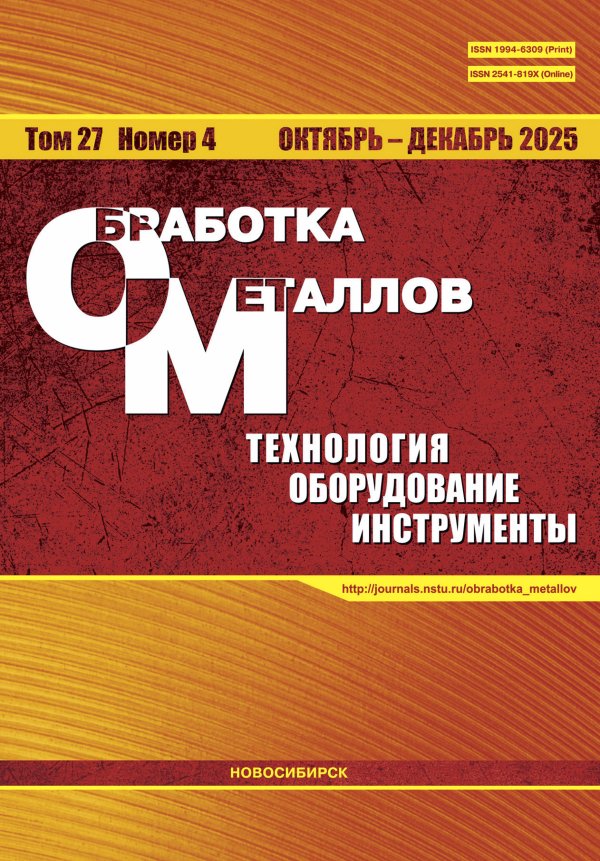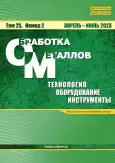In-situ анализ многослойных покрытий ZrN/CrN в процессе термического воздействия
- Авторы: Воронцов А.В.1, Филиппов А.В.1, Шамарин Н.Н.1, Москвичев Е.Н.1, Новицкая О.С.1, Княжев Е.О.1, Денисова Ю.А.1, Леонов А.А.1, Денисов В.В.1
-
Учреждения:
- Выпуск: Том 25, № 2 (2023)
- Страницы: 68-80
- Раздел: МАТЕРИАЛОВЕДЕНИЕ
- URL: https://bakhtiniada.ru/1994-6309/article/view/301443
- DOI: https://doi.org/10.17212/1994-6309-2023-25.2-68-80
- ID: 301443
Цитировать
Аннотация
Ключевые слова
Об авторах
А. В. Воронцов
Email: vav@ispms.ru
канд. техн. наук, Институт физики прочности и материаловедения СО РАН, пр. Академический, 2/4, г. Томск, 634055, Россия, vav@ispms.ru
А. В. Филиппов
Email: Andrey.V.Filippov@yandex.ru
канд. техн. наук, Институт физики прочности и материаловедения СО РАН, пр. Академический, 2/4, г. Томск, 634055, Россия, Andrey.V.Filippov@yandex.ru
Н. Н. Шамарин
Email: shnn@ispms.ru
Институт физики прочности и материаловедения СО РАН, пр. Академический, 2/4, г. Томск, 634055, Россия, shnn@ispms.ru
Е. Н. Москвичев
Email: em_tsu@mail.ru
канд. физ.-мат. наук, Институт физики прочности и материаловедения СО РАН, пр. Академический, 2/4, г. Томск, 634055, Россия, em_tsu@mail.ru
О. С. Новицкая
Email: nos@ispms.tsc.ru
Институт физики прочности и материаловедения СО РАН, пр. Академический, 2/4, г. Томск, 634055, Россия, nos@ispms.tsc.ru
Е. О. Княжев
Email: zhenya4825@gmail.com
Институт физики прочности и материаловедения СО РАН, пр. Академический, 2/4, г. Томск, 634055, Россия, zhenya4825@gmail.com
Ю. А. Денисова
Email: yukolubaeva@mail.ru
канд. физ.-мат. наук, Институт сильноточной электроники СО РАН, пр. Академический, 2/3, г. Томск, 634055, Россия, yukolubaeva@mail.ru
А. А. Леонов
Email: laa-91@yandex.ru
Институт сильноточной электроники СО РАН, пр. Академический, 2/3, г. Томск, 634055, Россия, laa-91@yandex.ru
В. В. Денисов
Email: volodyadenisov@yandex.ru
канд. техн. наук, Институт сильноточной электроники СО РАН, пр. Академический, 2/3, г. Томск, 634055, Россия, volodyadenisov@yandex.ru
Список литературы
- Oxidation behavior, thermal stability, and the coating/substrate interface evolution of CrN-coated Zircaloy under high-temperature steam / J. Liu, Z. Hao, Z. Cui, D. Ma, J. Lu, Y. Cui, C. Li, W. Liu, S. Xie, P. Hu, P. Huang, G. Bai, D. Yun // Corrosion Science. – 2021. – Vol. 185. – P. 109416. – doi: 10.1016/j.corsci.2021.109416.
- Reverse engineering of mechanical and tribological properties of coatings: results of machine learning algorithms / D.M. Pashkov, O.A. Belyak, A.A. Guda, V.I. Kolesnikov // Physical Mesomechanics. – 2022. – Vol. 25. – P. 296–305. – doi: 10.1134/S1029959922040038.
- A comparative study of CrN, ZrN, NbN and TaN layers as cobalt diffusion barriers for CVD diamond deposition on WC–Co tools / J.P. Manaud, A. Poulon, S. Gomez, Y.L. Petitcorps // Surface and Coatings Technology. – 2007. – Vol. 202. – P. 222–231. – doi: 10.1016/j.surfcoat.2007.05.024.
- Lee D.B., Lee Y.C., Kwon S.C. High temperature oxidation of TiCrN coatings deposited on a steel substrate by ion plating // Surface and Coatings Technology. – 2001. – Vol. 141. – P. 232–239. – doi: 10.1016/S0257-8972(01)01237-3.
- Structure and properties of CrN/TiN multilayer coatings produced by cathodic arc plasma deposition on copper and beryllium-copper alloy / A.V. Kolubaev, O.V. Sizova, Y.A. Denisova, A.A. Leonov, N.V. Teryukalova, O.S. Novitskaya, A.V. Byeli // Physical Mesomechanics. – 2022. – Vol. 25. – P. 306–317. – doi: 10.1134/S102995992204004X.
- Transient experiments on oxidation and degradation of Cr-coated Zircaloy in steam up to 1600 C / J. Liu, C. Tang, M. Steinbrück, J. Yang, U. Stegmaier, M. Große, D. Yun, H.J. Seifert // Corrosion Science. – 2021. – Vol. 192. – P. 109805. – doi: 10.1016/j.corsci.2021.109805.
- Oxidation kinetics of Cr-coated zirconium alloy: Effect of coating thickness and microstructure / E.B. Kashkarov, D.V. Sidelev, M.S. Syrtanov, C. Tang, M. Steinbrück // Corrosion Science. – 2020. – Vol. 175. – P. 108883. – doi: 10.1016/j.corsci.2020.108883.
- Discussion on structural parameters of the multilayer ZrC/TaC coatings based on stress analysis and ablation behaviors / D. Hu, Q. Fu, X. Li, L. Zhou, J. Zhang // Surface and Coatings Technology. – 2022. – Vol. 435. – P. 128243. – doi: 10.1016/j.surfcoat.2022.128243.
- Chen Y.I., Lo H.H., Ke Y.E. Thermal stability of laminated Ru–Al/Ru–Si–Zr coatings on Inconel 617 // Surface and Coatings Technology. – 2020. – Vol. 399. – P. 126194. – doi: 10.1016/j.surfcoat.2020.126194.
- Protection of Zr alloy under high-temperature air oxidation: a multilayer coating approach / D.V. Sidelev, M.S. Syrtanov, S.E. Ruchkin, A.V. Pirozhkov, E.B. Kashkarov // Coatings. – 2021. – Vol. 11. – P. 227. – doi: 10.3390/coatings11020227.
- Boretius M., Krappitz H., Rass I. Wear protection coatings generated by brazing, sintering and heat treatment in vacuum // Tribologie und Schmierungstechnik. – 2017. – Vol. 64. – P. 35–9.
- Gérard B. Application of thermal spraying in the automobile industry // Surface and Coatings Technology. – 2006. – Vol. 201. – P. 2028–2031. – doi: 10.1016/j.surfcoat.2006.04.050.
- High-rate deposition of thick (Cr,Al)ON coatings by high speed physical vapor deposition / K. Bobzin, T. Brögelmann, C. Kalscheuer, T. Liang // Surface and Coatings Technology. – 2017. – Vol. 322. – P. 152–162. – doi: 10.1016/j.surfcoat.2017.05.034.
- Structural aspects of wear resistance of coatings deposited by physical vapor deposition / V.I. Kolesnikov, O.V. Kudryakov, I.Y. Zabiyaka, E.S. Novikov, D.S. Manturov // Physical Mesomechanics. – 2020. – Vol. 23. – P. 570–583. – doi: 10.1134/S1029959920060132.
- Microstructures of Ni–AlN composite coatings prepared by pulse electrodeposition technology / F. Xia, H. Xu, C. Liu, J. Wang, J. Ding, C. Ma // Applied Surface Science. – 2013. – Vol. 271. – P. 7–11. – doi: 10.1016/j.apsusc.2012.12.064.
- Composition, structure and properties of Mo-N coatings formed by the method of vacuum-arc plasma-assisted deposition / O.V. Krysina, Y.F. Ivanov, N.N. Koval, N.A. Prokopenko, V.V. Shugurov, E.A. Petrikova, O.S. Tolkachev // Surface and Coatings Technology. – 2021. – Vol. 416. – P. 127153. – doi: 10.1016/j.surfcoat.2021.127153.
- Microstructure, high-temperature corrosion and steam oxidation properties of Cr/CrN multilayer coatings prepared by magnetron sputtering / Z. Li, C. Liu, Q. Chen, J. Yang, J. Liu, H. Yang, W. Zhang, R. Zhang, L. He, J. Long, H. Chang // Corrosion Science. – 2021. – Vol. 191. – P. 109755. – doi: 10.1016/j.corsci.2021.109755.
- Khamseh S., Araghi H. A study of the oxidation behavior of CrN and CrZrN ceramic thin films prepared in a magnetron sputtering system // Ceramics International. – 2016. – Vol. 42. – P. 9988–9994. – doi: 10.1016/j.ceramint.2016.03.101.
- PseudoVoigt, (n.d.). – URL: https://docs.mantidproject.org/nightly/fitting/fitfunctions/PseudoVoigt.html (accessed: 11.04.2023).
- Горелик С.С., Расторгуев Л.Н., Скаков Ю.А. Рентгенографический и электроннооптический анализ. – 2-е изд., испр. и доп. – М.: Металлургия, 1970. – 366 с.
- Русаков А. Рентгенография металлов. – М.: Атомиздат, 1977. – 480 с.
Дополнительные файлы







